
Template de backlog do Scrum
O template de backlog do Scrum ajuda as equipes ágeis a organizar e priorizar tarefas, melhorando as estimativas de tempo e aprimorando a compreensão das dependências e bloqueadores.
melhor para
Gerenciamento de projeto
Desenvolvimento de software
Principais funções
Planejamento de tarefas
Priorização
Gestão de pipelines

O que é o template de backlog do Scrum?
Organização aprimorada
O template de backlog do Scrum no Jira Software oferece às equipes ágeis uma abordagem sistemática e reutilizável para organizar o projeto geral e o trabalho focado em cada sprint. Ele ajuda a capturar todas as funções e informações de suporte necessários, como histórias do usuário e requisitos, de maneira consistente, estruturada e centralizada.
Lista priorizada de tarefas
Priorizar e estimar tarefas é simples com o template de backlog do Scrum. Equipes ágeis podem transferir tarefas de alta prioridade para o topo, identificar dependências e localizar possíveis obstáculos com rapidez. A repriorização é simples, e a movimentação das dependências é automática para proporcionar uma noção clara do trabalho.
O que está incluso no template de backlog do Scrum?
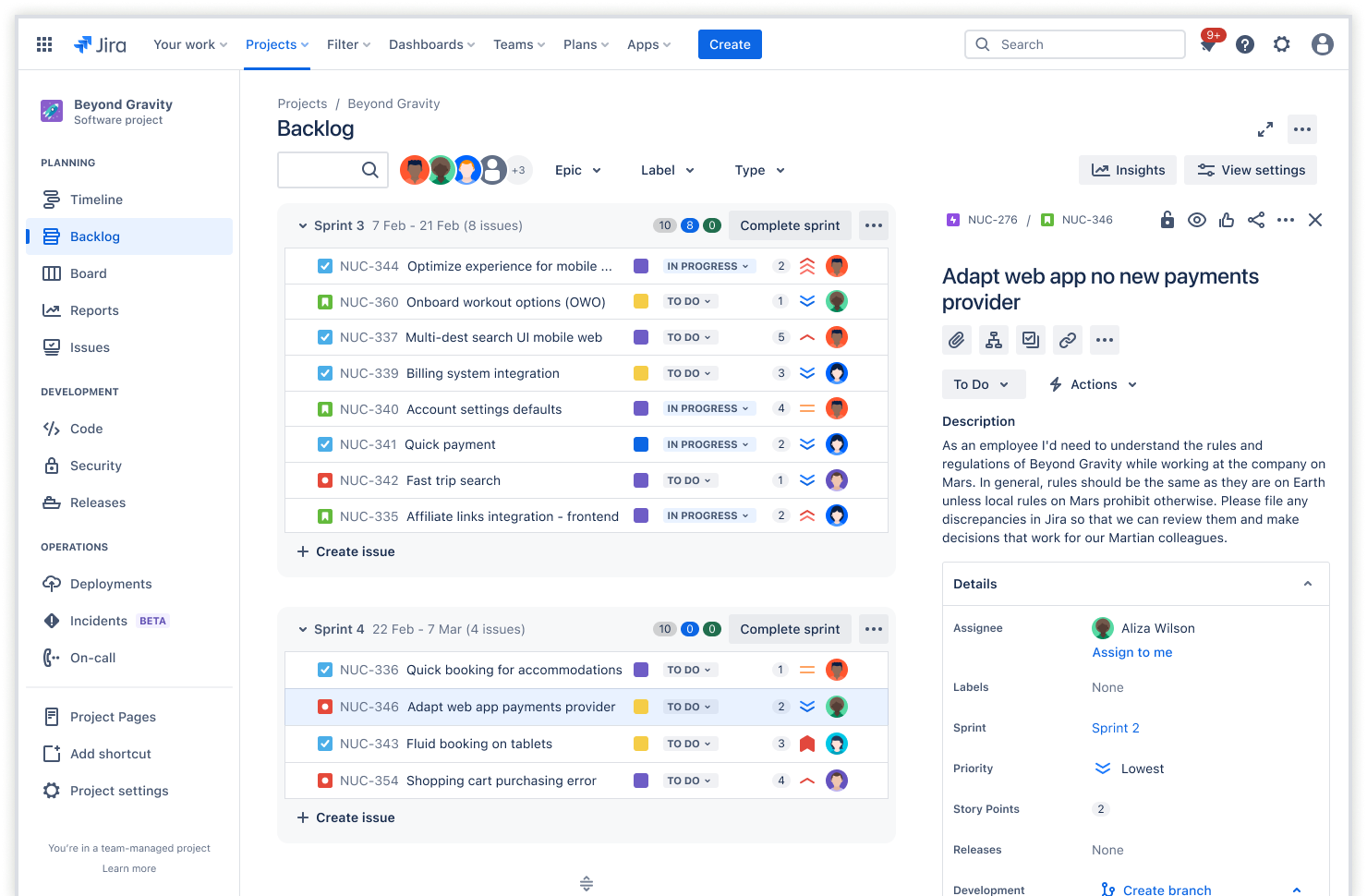
Backlog do produto
O template de backlog do produto do Scrum inclui todo o trabalho de um projeto, como backlogs e sprints do produto. Em geral, os projetos têm vários backlogs de produto para diferentes áreas de foco, como novas funções, otimização do produto ou experiência do usuário. As equipes identificam e priorizam tarefas dentro de cada backlog do produto. O trabalho começa quando as tarefas são incorporadas aos sprints do Scrum.
As equipes podem incluir informações relevantes, como especificações, histórias do usuário e valor. Priorize itens nos backlogs do produto com base no valor comercial e nas metas do projeto. Desse modo, as equipes são mais eficientes ao criar o backlog do sprint, também conhecido como iteração.
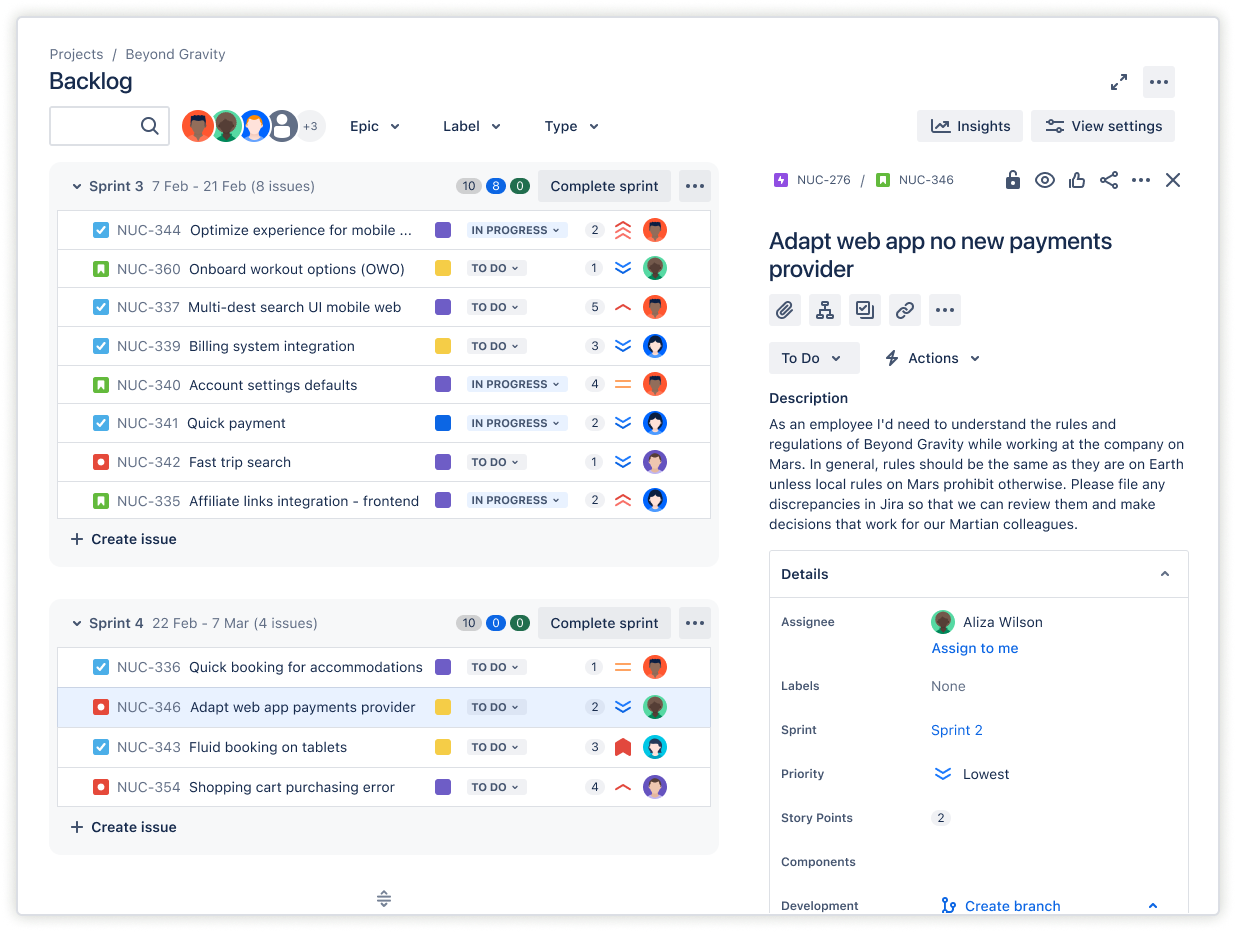
Backlog do sprint
Os sprints são conjuntos focados de tarefas para a entrega de resultados incrementais. Muitas equipes também identificam os sprints com marcos. O template de backlog do sprint do Scrum inclui o planejamento de sprint.
O backlog do sprint é um subconjunto do backlog do produto, que contém as tarefas em que as equipes estão trabalhando ou planejam trabalhar em breve. Com a divisão em tarefas menores, as equipes conseguem concluir o sprint com mais rapidez e identificar possíveis bloqueadores.
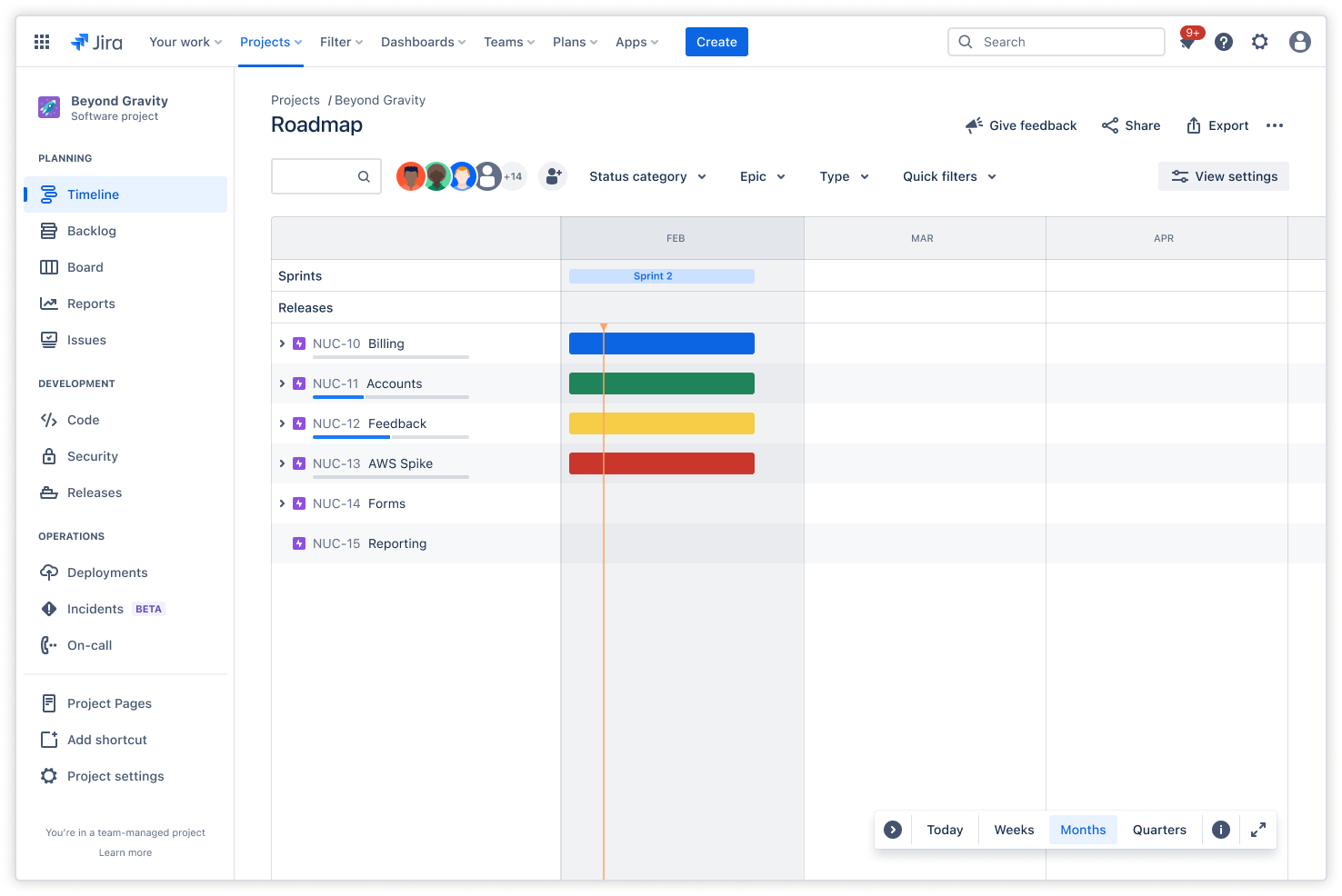
Visualização Cronograma
A visualização Cronograma ajuda equipes e partes interessadas a ficarem informadas sobre o progresso dos próximos prazos e das tarefas relacionadas. Adicionar epics e mapear itens de trabalho proporciona uma compreensão clara das dependências e de como as tarefas se encaixam. Uma visão centralizada e interativa facilita a visualização de conflitos, tarefas duplicadas, restrições de recursos e outros possíveis obstáculos.
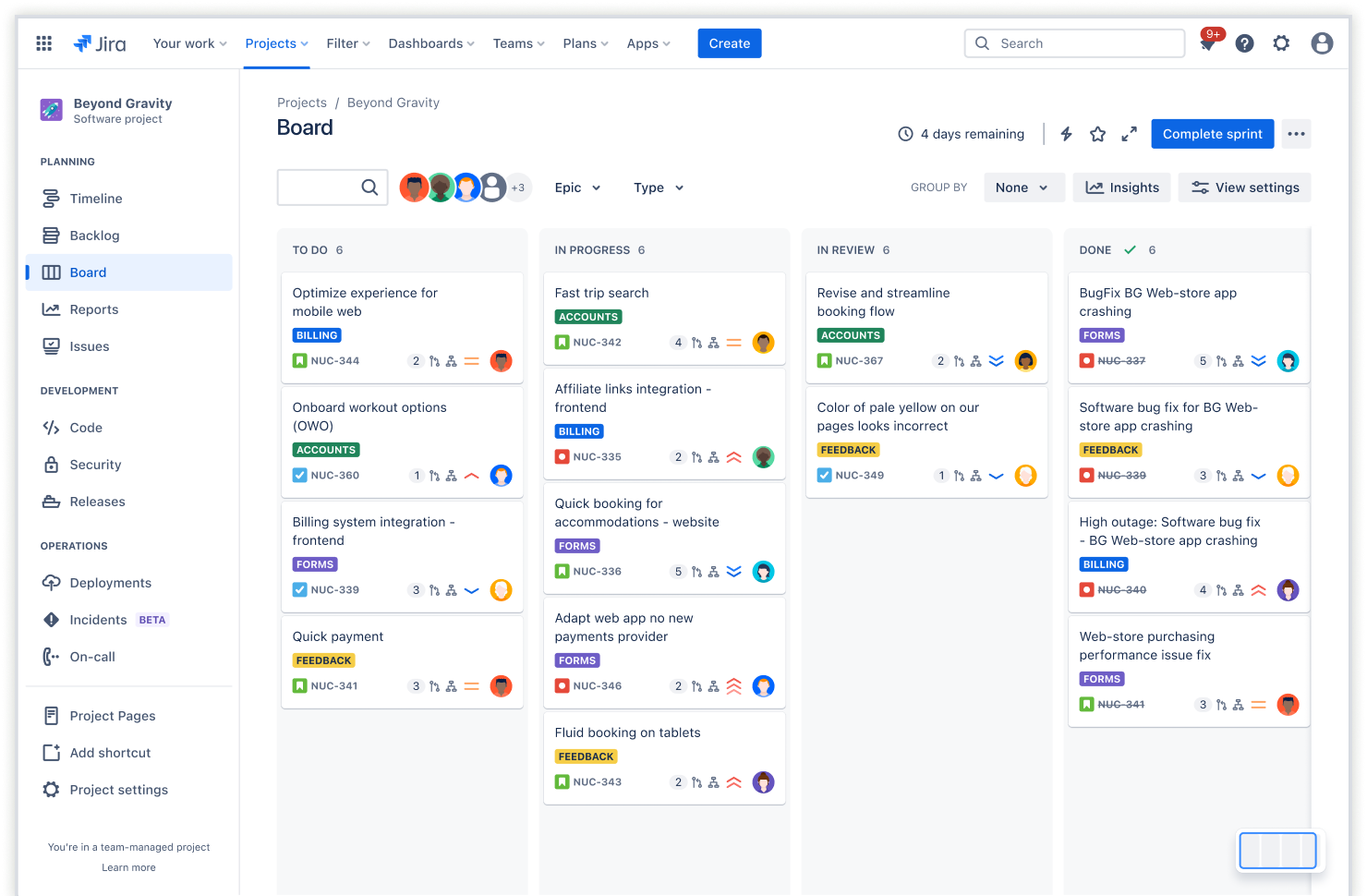
Quadros Scrum
Os Quadros Scrum transformam tarefas em representações visuais gerenciáveis do projeto inteiro. A apresentação visual auxilia as equipes ágeis a reconhecer e dividir representações grandes e complexas do trabalho em tarefas menores e mais gerenciáveis, o que ajuda a eliminar surpresas, manter a equipe concentrada no sprint e, por fim, lançar com mais rapidez.
Como começar a usar o template de backlog do Scrum
- 1
Defina histórias do usuário
Para equipes ágeis, definir histórias do usuário ajuda os membros da equipe a entender o que estão criando e por quê. As histórias do usuário mostram o que a função oferece do ponto de vista do usuário. Por exemplo, um funcionário da folha de pagamento deve ser capaz de agendar depósitos automáticos e diretos nas contas bancárias dos funcionários em um dia específico do mês.
- 2
Identifique tarefas essenciais e marcos
O agrupamento de histórias do usuário em funcionalidades de usuário final pode ajudar as equipes a identificar as principais tarefas e criar marcos. Esses pontos de referência se alinham às metas gerais do projeto, como o agendamento da transferência da folha de pagamento. Eles incluem todas as tarefas e histórias do usuário dentro dessa meta. A identificação de marcos ajuda as equipes a definir os requisitos para a meta.
- 3
Priorize histórias do usuário no backlog do produto
Algumas histórias do usuário podem ter uma prioridade mais alta para o usuário e para a empresa. Outras podem apenas ser boas de ter. Priorizar histórias do usuário concentra as equipes nas tarefas de maior valor. Consiga isso por meio da colaboração em projetos. Diferentes membros da equipe trazem perspectivas únicas sobre complexidades ou dependências ocultas. As prioridades podem mudar, e a equipe deve continuar refinando o backlog para que reflita as mudanças.
- 4
Divida as histórias de usuários em tarefas
Entender as histórias de usuários ajuda a identificar todas as tarefas que as equipes devem concluir para atingir a meta geral. Dividir as histórias em tarefas menores e gerenciáveis permite que as equipes vejam lacunas, requisitos ausentes e obstáculos. Isso melhora a estimativa da linha do tempo.
- 5
Estime o esforço para cada tarefa
Depois de dividir as histórias em tarefas obrigatórias, revise as tarefas quanto à complexidade. Para obter uma estimativa de tempo precisa, revise a tarefa e seus requisitos mais uma vez.
As equipes ágeis geralmente usam técnicas de estimativa, como pontos de história, em que todos os membros da equipe avaliam o trabalho com base em sua experiência. Outra abordagem é empregar estimativas baseadas no tempo, em que a equipe identifica a data de conclusão e, em seguida, trabalha de trás para frente para estimar as tarefas. Essa abordagem pode ser um bom exercício para concordar com tarefas e metas de alta prioridade.
- 6
Crie o backlog do sprint
Para criar o backlog do sprint — o trabalho que compreende a função ou o lançamento do produto — selecione as tarefas priorizadas no backlog do produto. Atribua recursos com base na experiência e na capacidade. Procure conflitos, como um membro da equipe sobrecarregado.
Estabeleça uma meta de sprint realista que se alinhe aos objetivos do projeto. A base para a meta vem do trabalho que a equipe já fez ao priorizar histórias de usuários e estimar tarefas.
- 7
Faça revisões e atualizações regulares
Fazer com frequência o refinamento do backlog e as revisões de sprint durante todo o ciclo de vida do projeto ajuda as equipes a se adaptarem às mudanças de prioridades ou aos novos requisitos. O backlog vai mudar com feedback adicional e novos insights.
Ambientes altamente colaborativos capacitam os membros da equipe a detectar itens e oferecer sugestões. Informações valiosas tornam as mudanças nas metas e no backlog mais facilmente compreendidas e aceitas.
Templates relacionados
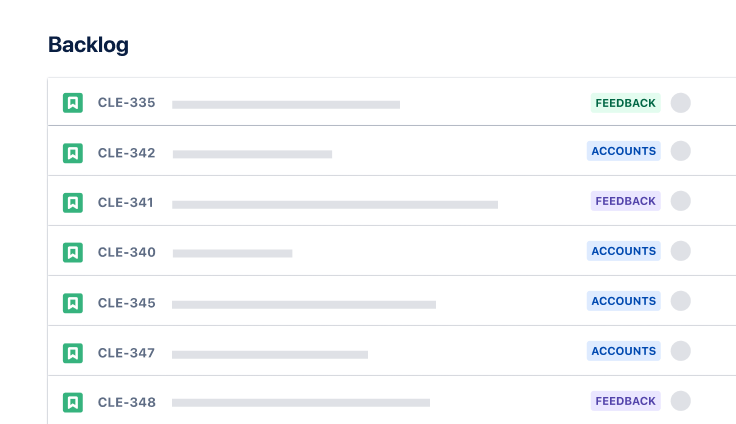

Template de backlog do Sprint
Ajude equipes ágeis a gerenciar os sprints com mais eficiência.

Desenvolvimento de software
Template de Scrum
Visualize, acompanhe e gerencie o trabalho com facilidade de sprint em sprint.